Twitter is making a move to become the jumping off point for discovering, browsing and accessing the mobile app ecosystem, the company announced yesterday, in a somewhat understated event only developers were invited to attend. The event, due to its nature, was filled with geekier terminology like “footer tags,” “deep linking,” and “URL schemes,” making summaries of its announcements hard to parse by the everyday Twitter user who isn’t as familiar with what some of these things may mean.
So let’s clarify: Twitter wants to connect its users with content found in the broader mobile app universe, including products for sale from e-commerce companies, the mobile applications themselves, as well as other media, such as photos, videos, article snippets, and soon music, too.
This a major step forward for a service which begin life as a way to post brief, 140-character text-based thoughts, inspired by SMS.
just setting up my twttr
— Jack Dorsey (@jack) March 21, 2006
With Twitter Cards, which just went live in Twitter’s iOS, tweets are no longer boring status updates like the above, but are rich, perhaps even interactive elements, which will not only help to increase users’ time spent using Twitter and viewing content on its service, but that can also help send increased traffic to mobile applications.
Support for Twitter’s App Cards went live on iOS today.
There are two critical pieces to what Twitter announced: a way to increase e-commerce conversions via mobile apps, and a way to boost discovery and app installs for any mobile developer.
Twitter To Impact E-Commerce Conversions
Addressing the first item, the way this works is that Twitter will allow tweets to link to other applications. This is what Twitter refers to as “deep linking.” For e-commerce applications, being able to seamlessly move from a tweet to an app users already have installed on their devices – which already contains their account info (name, address, credit card, etc.) – will go a long way to increase e-commerce conversions versus sending those same clicks to the mobile web.
Fred Wilson, of Union Square Ventures, remarks on his blog that while Twitter’s phrasing of the announcement “might not seem like much,” it’s actually “a big deal” for e-commerce apps. “For many e-commerce and marketplace businesses, this will be a huge help in delivering transactions instead of page views,” he says.
E-commerce conversions are a big challenge, with typical conversion rates (the ratio of a site’s sales to a site’s visits) around 2 or 3 percent. On mobile, it’s even more difficult because of the tediousness of typing onto smartphones’ small screens. By instead pointing a Twitter user interested in a particular product to an app that already contains users’ payment info, there’s a better chance for serendipity and impulse purchases.
Twitter’s early partners on Twitter Cards include e-commerce players like (Wilson’s firm’s) portfolio company Etsy, as well as Gumroad, Storenvy, and Wine Library. Other partners, like Jawbone and Angry Birds’ maker Rovio, also sell physical goods, though not only via the web in the traditional e-commerce sense. Still, they too could take advantage of the simplified app-to-app flow to increase sales of their own items, if they choose.
Boosting App Discovery And Installs
But it’s not only e-commerce players who will benefit from the deep app linking. Also benefiting is any mobile app developer looking to increase their app’s discoverability – and then, hopefully, decrease the cost associated with acquiring users through other channels like pay-per-install schemes, for instance.
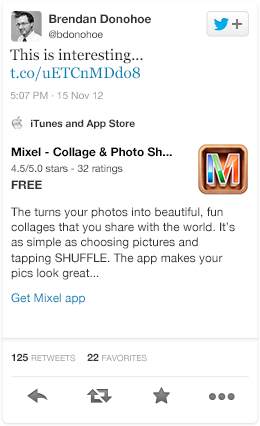 Developers can now include “footer tags” on their app’s tweets which are just links that appear below the tweet which point users to the appropriate mobile app store (iPhone, iPad, or Google Play for Android devices), encouraging users to download the app whose content they’re viewing.
Developers can now include “footer tags” on their app’s tweets which are just links that appear below the tweet which point users to the appropriate mobile app store (iPhone, iPad, or Google Play for Android devices), encouraging users to download the app whose content they’re viewing.
For example, social messaging platform Path, Flickr, Foursquare, and Twitter’s own video app Vine, will be among the first to adopt this new Cards feature.
As users tweet from the apps, their Twitter followers will have only to click on a link to download the app their friend is using if they want to check it out, too. It’s closing a loop of sorts – before, users would connect their mobile apps to Twitter, share content from the app, and people would click links and tweets to view that content. But that would be the end of it. If users then wanted to try the app, and hadn’t yet downloaded it, they would have to manually do a search in the app store to install it.
The alternative was moving Twitter users to web, and then from web to app. On iOS, Apple only recently (in iOS 6) added this connectivity in the form of “Smart Banners” which allow a web page to display a pop-up banner suggesting the link to download that app from the App Store, or opening the web content within the app. (There’s a similar plugin for Android).
But Twitter’s newly announced “deep app linking” goes a step further. Instead of taking a user from mobile web to app, it takes the user from app to app. That is, Twitter’s app to the developers’ app.
Genius, right? After all, a lot of the activity taking place on today’s “mobile web” is actually happening within apps. And unlike on the desktop Internet, these apps have not been hyperlinked to enable easy navigation between them. Instead, they’ve been standalone, isolated pockets of content, requiring users switch between them themselves. That’s been a problem for a number of reasons, but notably for app developers, because people only have so much mental bandwidth when it comes to accumulating and then remembering to launch and use the applications they download.
Twitter, which has long since transitioned from text-based thoughts to a content discovery network, is ideal for pushing people around this web of apps. And for developers, the benefit is that they can use Twitter as the jumping off point to move people from viewing content to actual (revenue-generating) in-app activity.
Backing Up: But On Mobile, Facebook Is Still King Of Social
It’s a big leap for Twitter, of course, to enable these connections, but lets pull back for a minute from being overly enthusiastic here. For any of this to really matter, Twitter needs to find a foothold of a significant and meaningful size on mobile.
So far, it’s still dwarfed by Facebook, which Flurry just reported today comprises 18 percent of users’ on-device activity. Twitter, along with all other non-Facebook social networks, only accounts for 6 percent of user activity in comparison.
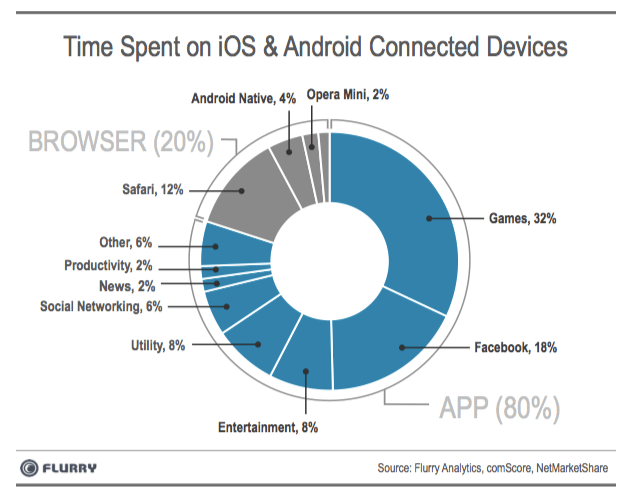
And Facebook, too, has been working on its own mechanisms for moving users from social network to mobile apps. It taps into Facebook’s social graph to make recommendations. Facebook’s App Center, available on both web and mobile, is visited by hundreds of millions of users per month. Twitter, meanwhile, as a whole, has over 200 million monthly active users, out of over double that who are registered on the service.
Facebook’s app install ads, a new business for Facebook’s mobile future, are doing well, too. Twitter could go in this direction now as well, with Twitter app install Cards leading to app install ads, essentially cloned from Facebook’s model.
Also, Facebook has 680 mobile monthly actives, while 120 million Twitter users are mobile monthly actives (Twitter said this February that 60 percent of its 200 million monthly actives log on via mobile at least once per month.) Twitter touted this group as skewing younger, noting that those 52 percent of those 18-34 are more likely to login on mobile than other groups.
But being young and mobile isn’t only Twitter’s thing.
Facebook, despite anecdotal reports to the contrary, isn’t struggling to find traction with its youngest users. According to Pew Internet & American Life’s latest figures, 86 percent of Internet users 18 to 29 use Facebook today. The site is not in decline, and according to new data from J.P. Morgan analyst Doug Anmuth (via All Things D), Facebook is growing more than other mobile competitors like Twitter, Snapchat, WhatsApp and even its own property, Instagram.
So even as this next, new generation of web – or rather mobile web – users step in to engage with content on social services, it’s not necessarily Twitter which will serve as their main gateway to the app universe. That’s not to say that Twitter won’t be an important, and growing, channel to connect users to apps, but it might be more fair to dub it a window and not a doorway at this time.

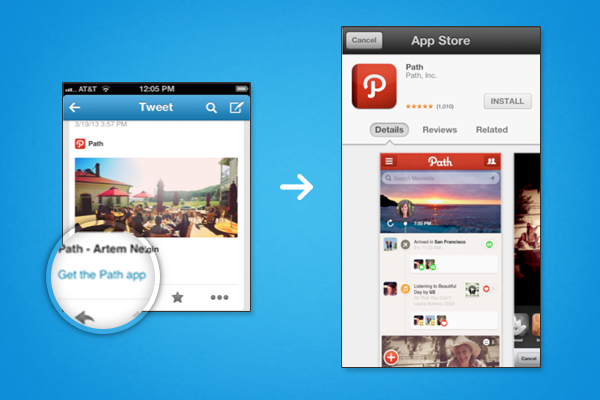
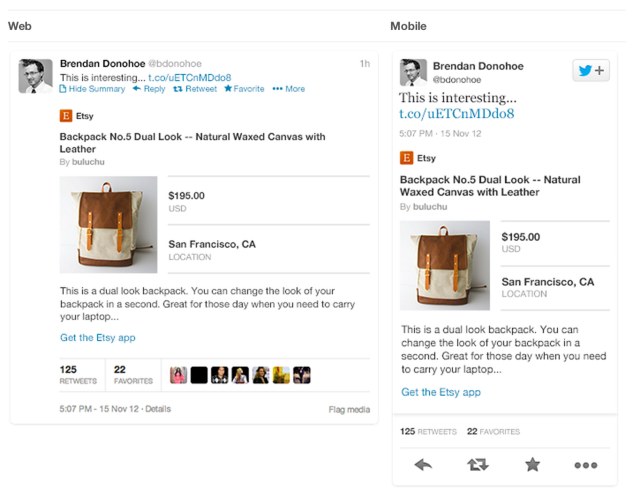

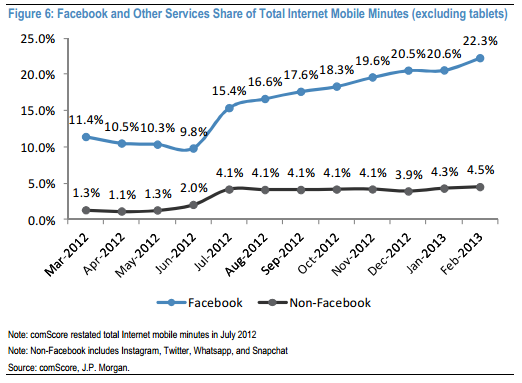





























Comment